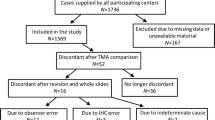Abstract.
Steroid hormone receptors are important prognostic and predictive factors in breast carcinomas. Thus their determination is of essential importance. The aims of this study were to assess the quality of the immunohistochemical assays, and to assess the interlaboratory and interobserver variability performed by different laboratories in Austria. Ten unstained slides for interlaboratory variability evaluation and ten immunohistochemically prestained slides for interobserver variability evaluation from breast carcinomas known to show different degrees of steroid hormone receptor expressions were sent to 32 surgical pathology laboratories in Austria (participation rate 97%). The participants were requested to perform their in-house immunohistochemistry (IHC) technique for estrogen receptors (ERs) and progesterone receptors (PRs) on the unstained slides. All slides were evaluated by estimating percentage and intensity of stained nuclei semiquantitatively. From these data the Reiner, Remmele and the Allred scores were calculated. A less than 10% cut-off level was chosen as threshold for positive cases. Regarding the series of prestained slides, both sensitivity and specificity were very high (>96.88%); false-positive and -negative rates were low (<3.31%). Interobserver variability showed moderate multirater kappa values concerning the ER (Reiner score: kappa=0.57) and PR scores (Reiner score: kappa=0.53). The agreement among observers was better for negative cases than positive cases. In-house slides representing interlaboratory variability showed fair to moderate kappa values concerning the ER and PR scores (kappa for ER Reiner score=0.41; PR=0.32). In this slide series, sensitivity and specificity were high (>82.2%) and false-positive or -negative rates were low in ER cases (<3.03) and moderately low in PR cases (17.46%). These results demonstrate that variability is higher when participants use their own staining method. In more detailed analysis, the automated IHC techniques showed an advantage over manual techniques concerning interlaboratory variability. There exists no difference in reproducibility with respect to scoring systems for steroid hormone receptor estimation.
Similar content being viewed by others
Author information
Authors and Affiliations
Additional information
Electronic Publication
Rights and permissions
About this article
Cite this article
Regitnig, P., Reiner, A., Dinges, HP. et al. Quality assurance for detection of estrogen and progesterone receptors by immunohistochemistry in Austrian pathology laboratories. Virchows Arch 441, 328–334 (2002). https://doi.org/10.1007/s00428-002-0646-5
Received:
Accepted:
Issue Date:
DOI: https://doi.org/10.1007/s00428-002-0646-5




